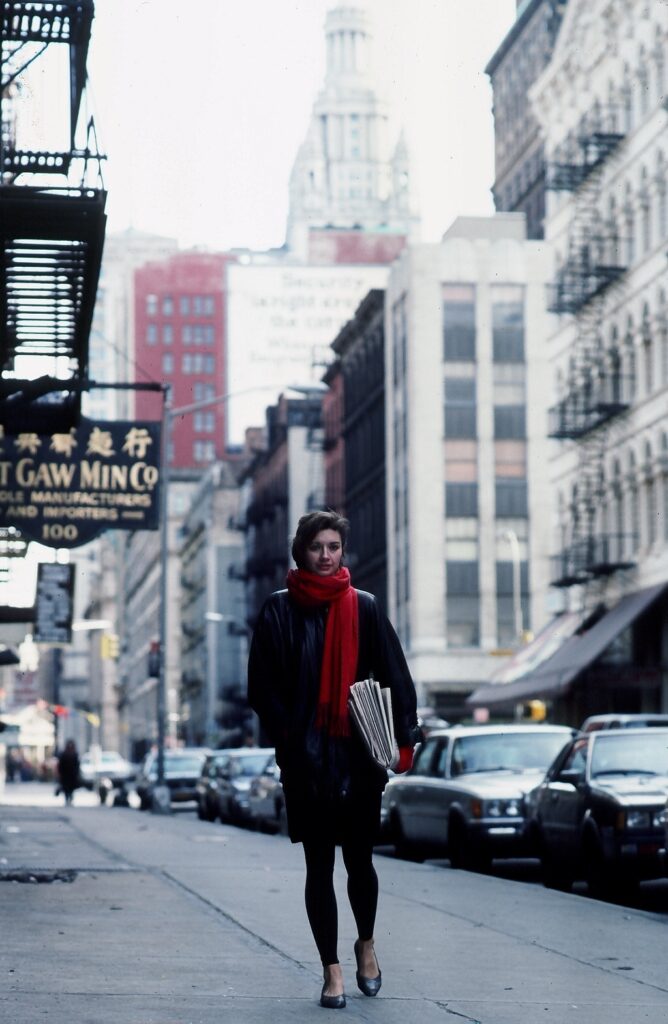
“Oskar Schlemmer’s Bauhaus Dances showed all the energy, wit, and understanding which made them important in the 1920s….McCall’s reconstruction was meticulous….The resulting dances were both beautiful and instructive.”
Ithaca Journal
Debra McCall is best known for her early 1980s reconstructions of Oskar Schlemmer’s Bauhaus Dances. Trained in ballet and modern dance with Martha Graham, she identified with the experimentalism of the Judson Dance Theater and early performance art. A series of museum exhibitions in the late 1970s-early 1980s on abstract geometric art of the 1920s inspired her to find an analog in the world of dance. While studying the geometric movement theories of Rudolf Laban, the Expressionist choreographer and creator of Labanotation and Laban Movement Analysis in the early twentieth century, she discovered the abstract geometric Bauhaus dances of painter/sculptor Oskar Schlemmer. A Eureka moment, she recognized Schlemmer’s Bauhaus dances as the dance analog and precursor to contemporary avant-garde dance and performance art for which she had been searching.
A series of fortuitous events led her to the only living performer of Schlemmer’s dances, Andreas (Andor) Weininger. Weininger and his wife Eva, also a Bauhausler, encouraged McCall to visit Ise Gropius, widow of Bauhaus founder Walter Gropius, in their landmark Lincoln, Massachusetts home. Charming and full of anecdotes, Ise insisted McCall cross into East Germany to visit the recently restored Bauhaus. “You cannot possibly reconstruct these dances without walking the architectonic stage Walter built for Oskar!” Weininger also had a requirement—to find Schlemmer’s original notes and sketches for the dances, believed destroyed in WW II. With few clues and letters from Ise and Andor in hand, McCall scoured museums and collections in West Germany and found the notes and sketches at the Staatsgalerie Stuttgart. A harrowing drive through a snowstorm with the Stasi trailing her, McCall finally made it to Dessau and spent a day walking the Bauhaus stage, her final task. The Bauhaus Dances reconstructions premiered to sold-out houses and critical acclaim at The Kitchen in 1982 and with additional reconstructions in 1984 at the Solomon R. Guggenheim Museum in conjunction with the exhibition “Kandinsky: Russian and Bauhaus Years: 1915-1933.” National and international tours followed, including the First Biennale de la Danse Lyon, France and a command performance at the Dessau Bauhaus where sixty-five years prior, the dances were first performed. A Labanotation score and film of the reconstructions produced by Goethe Haus New York reside at the New York Public Library of Performing Arts and the US Library of Congress. The film has been screened at numerous venues including the Aspen Institute, the American Dance Festival Dancing for the Camera International Festival of Film and Video Dance, the Museum of Modern Art exhibition Bauhaus 1919-1933: Workshops for Modernity, Performa 09, and the Taipei Arts Festival.
Following the abstract geometric Bauhaus Dances project, McCall yearned first for the informal and then, the lyrical. Convinced by her Norwegian dance intern to go to 125th Street to learn street dancing directly from kids at an abandoned storefront, McCall grappled with spinning on her head on cardboard but quickly finessed the electric boogie and moonwalk. Inspired by the young boys’ toework, she decided to return en pointe after 17 years. Classical Rap (1983) portrayed a ballerina rehearsing to a classical piece of music who suddenly finds her body out-of-control electric boogie-ing after her Walkman unexpectedly shifts to Grandmaster Flash’s The Message. That earned her a second National Endowment for the Arts Choreography Fellowship. After five years of touring with the Bauhaus Dances, McCall longed for the lyrical. Her pursuit of historical dance reconstruction extended to her project as the National Endowment for the Arts Advanced Design Fellow at the American Academy in Rome. Informed by art, myth, and ritual from research at archaeological sites in Rome and environs, private collections in southern Italy, and Egyptian temples, McCall mounted Psyche’s Last Task (1989), an evening length performance across the Academy grounds based on the second century CE Roman Metamorphoses by Apuleius.
As a 2017-18 Fulbright-Nehru Professional and Academic Excellence Award Fellow, McCall documented one thousand-year-old dance reliefs at the Thillai Nataraja temple in Chidambaram, India. An interdisciplinary project comprising dance, dance and art history, archaeology, and cultural preservation, many of these never-before published reliefs reveal the sacred dance tradition of Tamil Nadu temple culture. Recognizing the fragility of dance and dancers due to environmental devastation, political strife, and religious censorship, McCall founded Performing Matters, an organization dedicated to bringing awareness to
endangered dance and dancers.
A recipient of fellowships from the National Endowment for the Arts and the National Endowment for the Humanities, McCall has lectured at Harvard University, Cooper Union, the Art Institute of Chicago, Black Mountain College Museum and Arts Center, Temple University, The Watermill Center, Annamalai University, and other institutions. A member of the graduate faculties of New York University and Pratt Institute where she was Mellon Lecturer, McCall served as Director for Curriculum at Ross Institute and Dean of Cultural History for Ross School in East Hampton, NY where she oversaw the implementation of its innovative Evolution of Consciousness Spiral Curriculum. Her kinesthetic lessons on Roman architecture were included in the Smithsonian Institution/Annenberg documentary The Mind’s Intelligences, with Howard Gardner. While director of the dance/movement therapy program at Art Therapy Italiana Bologna, Italy, she created The Body of Myth workshop series, leading to a collaboration with the psychoanalyst and author James Hillman. McCall began her career in movement therapy at Bellevue Psychiatric Hospital, New York and studied under Irmgard Bartenieff who brought Labanotation and Laban Movement Analysis to the United States.